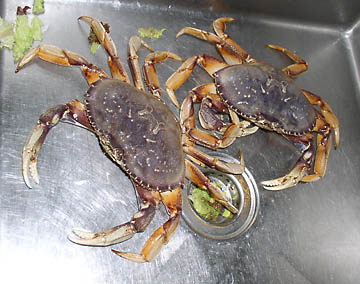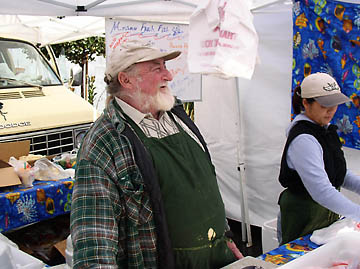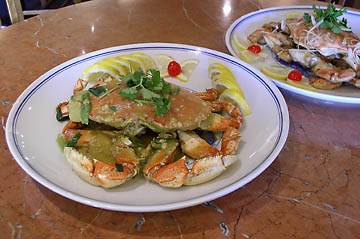A Season for Crab
by Robert Rich, November 2003, for MV Voice
Part one of a two-part article on Fresh Seafood

Dungeness crab season starts in California on November 15 every year. One of the most delectable gifts from the Pacific, this hefty six-legged crustacean gets its name from a small town at the tip of Washington's Olympic Peninsula. It thrives in our frigid coastal water from Alaska down to Morro Bay.
Dungeness crab has played a pivotal role in San Francisco's culinary tradition. Gold Rush escapees could stumble to the Barbary Coast for fresh cracked crab, crusty sourdough and a pint of steam beer, just as we can today. Cantonese cooks in Chinatown found subtle pairings with sautéed crab and delicate clear sauces.
I grew up anticipating my family's special crab dinners in winter. These slow meals promised delicious savagery, with rolled up sleeves and dripping hands, as we struggled to extract sweet morsels from every crevice of shell.
Dungeness Crab has meat so savory that many prefer to eat it unadorned, simply boiled in salted water, cracked and consumed. In such simple surroundings, one must find the freshest crab.
I asked James Pei, chef-owner of Cafe Yulong, to share some tips on shopping for fresh crab and fish. Pei is a master with seafood, and his restaurant on Dana Street serves some of the most delicate Chinese food in Mountain View.
Pei's advice proved so interesting that I decided to split his lessons into two articles. Next time I'll focus on fresh fish. At the end of this week's article, you'll find two recipes for Dungeness crab, courtesy of Cafe Yulong.
Look Alive
According to Chef Pei, you shouldn't buy dead raw crab (or lobster), which you can often find on ice at discount prices. These probably died in the tank, and would have been ill or starving. What little meat they have left will not fill the shell, and it will taste fishy rather than sweet. The meat will crumble rather than pull apart in strings.
Live crabs stop eating after they're caught. As they sit in tanks at the market, they begin to starve. When crustaceans starve, they metabolize their own tissue. Their meat turns mealy and soft. This process begins in 5-7 days.
Healthy crabs should look active in the tank. Choose the individuals that are fighting hard, dominating the other crabs. You can ask your merchant to weigh several crabs. The healthiest will be heavier for their size.
Make sure that the market keeps its fish tanks clean. Look for fresh clear tanks, not overcrowded or smelly. The best markets are the busiest ones, so their inventory rotates often.
Crab Boil
 On Sundays at the Mountain View
Farmer's Market, Patrick O'Shea sells the fish that he caught
the previous day, at his Mission Fresh Fish stand. He awakes
at 3 a.m. Sunday morning to boil his Saturday crab catch, to
sell cooked and iced at the market.
On Sundays at the Mountain View
Farmer's Market, Patrick O'Shea sells the fish that he caught
the previous day, at his Mission Fresh Fish stand. He awakes
at 3 a.m. Sunday morning to boil his Saturday crab catch, to
sell cooked and iced at the market.
I asked O'Shea to divulge his boiling methods. He uses a large pot with "a lot of salt" - I'll guess about 1/2 cup salt for two dozen crabs. At home you might use a 12-quart stockpot with 2-3 tablespoons of salt for one or two crabs.
He brings the salted water to a high rolling boil (the water should boil for about 30 min. to ensure even heat), then he places the live crab into the boiling water for 18 minutes.
He warns that the crab will continue to cook after pulling it from the water. To stop the cooking process, he immediately transfers the crab from the pot to a container of ice water (half ice cubes, half fresh water.) This stops the cooking, leaving the meat moist and tender.
I asked O'Shea how he likes to eat crab. "I like it best cold, boiled and cracked, with a salad and a sweet potato." James Pei agrees that crab doesn't need strong sauces, which only overpower its delicate flavor.
On the other hand, you can add strong spices to the boiling water for a classic Southern style crab boil. The spices will scent the crabmeat but they remain in the pot when you pull the crab out. The crab still takes center stage.
You can add equal amounts of salt, coriander, paprika, hot pepper flakes, thyme, and a few bay leaves for a savory seasoned crab pot. Smaller portions of dill, allspice, cloves and mustard seed will round out the flavors, with a few halves of onions and fresh lemons. You could also use a premixed crab-boil spice blend. Zatarain's makes the most common.
If you wish to serve crab hot from the pot, you might prefer to boil it only 10-12 minutes, rather than the 18 minutes that O'Shea uses. The crab will finish cooking as it makes its way to the table.
Not for the Squeamish
Many cultures prefer to clean their crab alive. Some feel that boiling pulls away the sweet flavors, and that live cleaning maintains the freshest tasting crabmeat. Some Americans might find this a bit troubling, especially when they're accustomed to finding their meat wrapped in plastic.
A topic worth examining (perhaps in another article), eating meat involves killing. When we start with a live animal in the kitchen, we get much closer to this reality, disturbing though it may feel.
Pei's recipes, which follow below, begin with live cleaning. However, if you buy live crab in the market, you can request that they clean it for you. Most good markets will perform this service, sometimes for a small fee.
If you feel brave, begin by grabbing the crab from behind. Healthy crabs move fast and can seriously hurt you with their pinchers. With a knife or screwdriver, pry the top of the shell off the crab and quickly scoop out the lungs and pith in the center.
This action kills the crab quickly, but you should still be careful of the pinchers, which can catch you with reflex action. Quickly break off the legs and claws, then with a cleaver cut the body in half lengthwise (down the axis of symmetry). One or two more cuts horizontally will break the center meat into manageable portions.
You might wish to keep the back shell for presentation after the meat is cooked. If so, clean the inside with a brush and water.
Lastly, crack the leg shells and body meat in various places with a hammer, to make it easier to eat later. You should cook the crab within a few hours of cleaning, keeping the meat cold until you're ready to cook.
Yulong's Ginger Onion Crab
 1 live crab, cleaned alive
1 live crab, cleaned alive
1 inch sliced fresh ginger root
1/4 cup chopped green onion
2 cups unsalted chicken stock
2 Tblsp. vegetable oil
2-4 Tblsp. rice wine
2 tsp. cornstarch
1/2 tsp. salt
Dash of sesame oil
Sprigs of fresh cilantro and green onion.
Prepare the ingredients in advance. Drain the crab of excess water. Slice the ginger into paper-thin coins. Mince the green onions, using mostly the white portion. Make a paste from the cornstarch by stirring in just enough water to reach the consistency of heavy cream.
Heat the chicken stock until almost boiling, and keep ready. Keep all the ingredients near the stove for quick access. The cooking portion goes very quickly.
Heat a large heavy wok or deep iron skillet on the highest flame until it is very hot. Add the oil to the wok and wait a moment until it ripples on the surface. Add the ginger and onions, and let sizzle for just 10-20 seconds. You will smell their aroma rise up from the oil.
Quickly add the crab parts. Watch out for splattering oil. It can cause serious burns. Toss the crab quickly for a moment (less than a minute), then add a dash of rice wine, which will quickly steam up. Continue to toss for another minute to integrate the ingredients.
Now add the 2 cups hot chicken stock and a dash of salt. Cover the wok and reduce for about 2 minutes. Now gradually stir in the cornstarch paste until the broth reaches a lightly thickened consistency, not too much. Dribble a tiny bit of sesame oil into the wok at the very end. Serve immediately.
For attractive presentation, you can re-assemble the pieces on a plate to form the shape of a crab, drizzle with sauce, then cover with the original shell top. Sprinkle with cilantro and strips of fresh green onion, and serve.
Yulong's Ghan Pung Crab
(Pan-fried with garlic)
1 live crab, cleaned alive
3 teeth garlic, crushed and diced
1 inch fresh grated ginger root
1/4 cup chopped green onion
1 hot pepper (optional) chopped
1/4 cup vegetable oil
White flour
1/2 cups unsalted chicken stock
1 Tblsp. rice wine
1 Tblsp. soy sauce
1 Tblsp. rice vinegar
1 tsp. sugar
1 tsp. black pepper
Dash of sesame oil
Sprigs of green onion
Prepare the ingredients before starting, as above. Dust the crab parts with white flour. Mix together ingredients for the sauce: chicken stock, rice wine, soy sauce, rice vinegar, sesame oil, sugar, black pepper.
With high flame in a large heavy skillet or wok, heat a small pool of vegetable oil (1/4 cup) until very hot. Add the flour-dusted crab parts (careful not to splash oil) and toss until the shells turn a light golden brown, probably 3-5 minutes. Watch carefully not to overcook.
Remove the crab parts onto a paper towel, and pour out some of the excess oil from the wok. The wok will retain heat.
Add the onions, ginger, garlic, and optional hot pepper. Fume in the wok for 10-20 seconds until aromatic. Immediately add the cooked crab back into the wok, then the sauce liquid. The liquid should heat up in just a moment.
Serve immediately; arrange decoratively with shell and green onions (see above) if desired.
Cafe Yulong
743 West Dana St., Mountain View
Lunch and dinner, Closed Mondays
(11:30am - 9:30 p.m., 10:30 p.m. Fri./Sat.)
Phone: 650-960-1677
Mission Fresh Fish
Mountain View Farmer's Market
Sundays, 8:00 a.m. - 1:00 p.m.